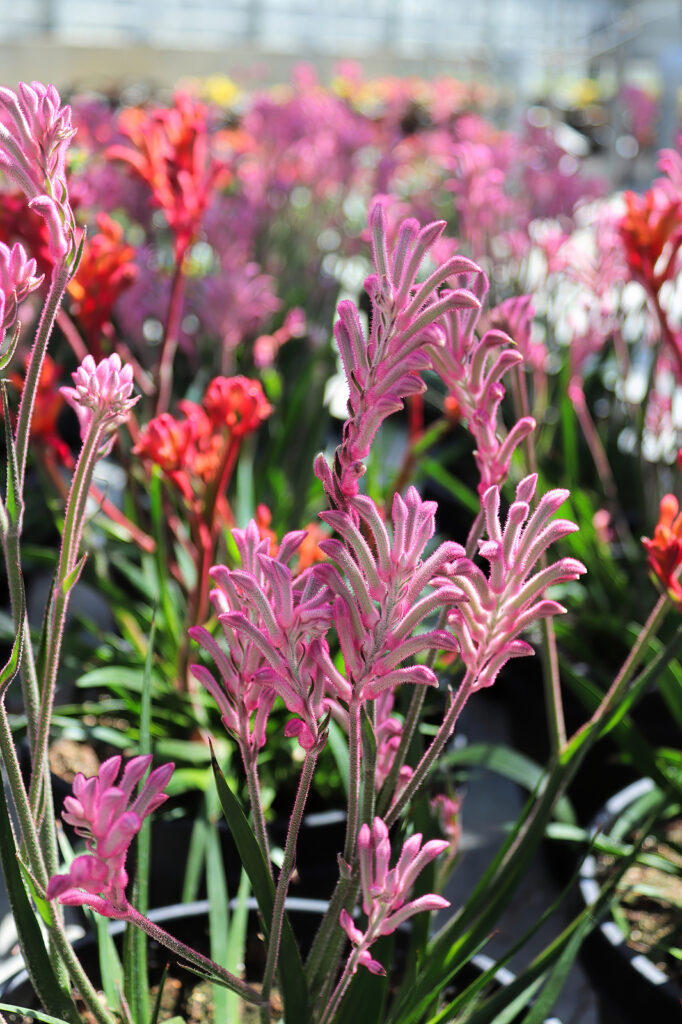Anigozanthos–commonly called kangaroo paw–is an herbaceous perennial that bears unique tubular in shape, fuzzy flowers that resemble a kangaroo paw. The flowers appear on branched or unbranched stems that grow several feet above the foliage. Flower colors range from red, pink, green, yellow, and orange.
Anigozanthos has strap-like leaves and a clumping growth habit. Flower stalks can often tower over leaf clumps, some growing 5 to 6 feet tall.
Anigozanthos prefers warm, dry areas in full and well-drained soil. Anigozanthos is short-lived and will become dormant under dry conditions of late summer and fall.
Anigozanthos is a genus of 11 species of evergreen, clump-forming perennials native to Southwestern Australia.
Get to know Anigozanthos
- Plant type: Evergreen perennial
- Growing zones and range: Zones 10-15
- Hardiness: Hardy to Zone 9
- Height and width: 24 inches (60cm) to 5 feet (1.5m) tall or more depending on the variety
- Foliage: Lance- or strap-shaped, light to dark green leaves, and erect, slender sometimes branched stems
- Flowers: Terminal racemes or panicles of unusual 2-lipped, tubular flowers said to resemble a kangaroo’s paw densely covered wtih red, orange, yellow, or green woolly hairs
- Bloom time: Spring to midsummer
- Uses: Border interest, cut flower, greenhouse
- Common name: Cat’s paw, kangaroo paw
- Botanical name: Anigozanthos
- Family name: Haemodoraceae
- Origin: Southwestern Australia

Where to plant Anigozanthos
- Grow Anigozanthos in full sun.
- Grow Anigozanthos in moist, but well-drained, humus-rich, sandy loam.
When to plant Anigozanthos
- Set container-grown Anigozanthos in the garden in spring or autumn.
Planting and spacing Anigozanthos
- Space Anigozanthos 24 to 32 inches apart.
How to water and feed Anigozanthos
- Water Anigozanthos to keep the soil just moist.
- Fertilize Anigozanthos with an all-purpose time release fertilizer in spring.
Anigozanthos care
- Mulch around Anigozanthos during dry weather to retain soil moisture.
- Drip irrigation is highly recommended; poor drainage often causes early death.
Anigozanthos pests and diseases
- Anigozanthus is occasionally bothered by bacterial or fungal leaf diseases.
Anigozanthos propagation
- Sow seed at 55°-64°F (13°-18°C) as soon as ripe.
- Divide Anigozanthos in spring. Plants should be divided every 2 or 3 years.
Anigozanthos varieties to grow
- Anigozanthus flavidus, tall kangaroo paw. Leaves 15 to 18 inches high; flowers can be yellow, pink, or red on stalks 5 to 6 feet high; most commonly cultivate species.
- A. humilis, cat’s paw. Small species just 3 to 6 inches high with grey-green sickle-shaped leaves; chartreuse green flowers with yellow; short-lived.
- A. manglesii, red and green kangaroo paw. Small species grows 8 to 12 inches high with light gray-green leaves; flowers are deep greed with bright red bases and stems.
- A. rufus, red kangaroo paw. Grows 1 to 2 feet high; dark green foliage; showy deep red flowers on branches talks.



